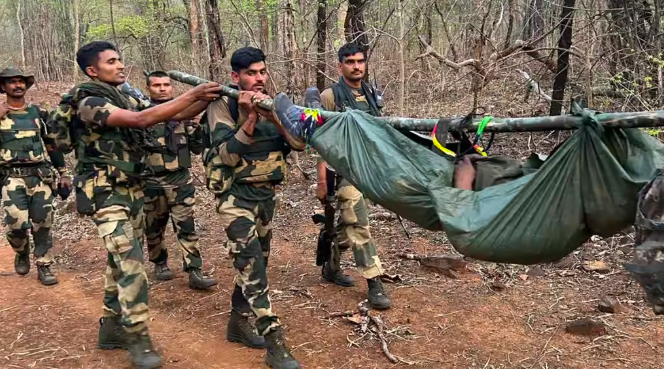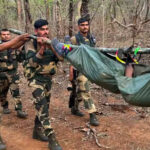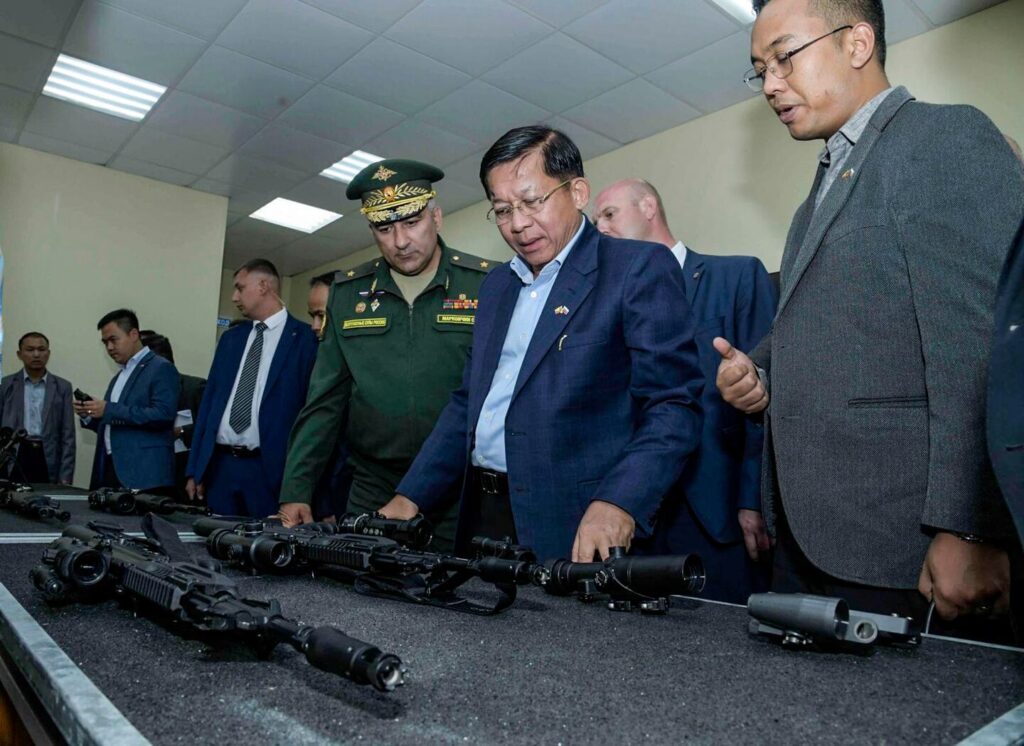MANTRAYA ANALYSIS#79: 14 MAY 2024
BIBHU PRASAD ROUTRAY
Abstract
In a matter of two weeks, the Communist Party of India-Maoist (CPI-Maoist) has lost 39 of its cadres in the Abujhmad area of Bastar, Chhattisgarh, considered to be the group’s stronghold. Among the dead are senior cadres of the key armed wing and levy-collecting formation. Such loss of key leaders and cadres is significant. However, is it the precursor to the end of left-wing extremism in the country?
The Kill

(Security personnel carry bodies of Maoists killed in the 16 April 2024 encounter.)
Two major security force operations have resulted in the killing in April of 39 cadres of the Communist Party of India-Maoist (CPI-Maoist) in the Bastar area in Chhattisgarh.
On 30 April, security forces killed ten Maoists including three women in a forest in Abujhmad area of Bastar, a Maoist stronghold in the western tip of the state. The early morning encounter between the insurgents and a large 800-strong security force contingent comprising District Reserve Guard (DRG) and the Special Task Force personnel took place across Narayanpur and Kanker districts. Among the dead were Maoist divisional committee member Joganna, as well as Vinay alias Ashok, a member of the North Bastar /Gadchiroli Division.
Earlier, on 16 April, three days ahead of the first phase of polling for India’s parliamentary elections, 29 CPI-Maoist cadres were killed in an encounter in Kanker district’s Haptola forests. The intense engagement took place following specific intelligence inputs about the grid location of a new Maoist camp established under the command of Shankar Rao, a member of the North Bastar Division of the group. A joint security team comprising 200 personnel drawn from the Border Security Force (BSF) and DRG launched a search operation in the area leading to a four-hour-long encounter.
The 29 dead bodies including those of Shankar Rao and another divisional committee member, Lalita. They were recovered, together with an array of weapons including 19 rifles. Fifteen of the dead were women. Both Shankar Rao and Lalita carried head money of Rupees 800,000.
Only three security force personnel were injured, and the two encounters have been hailed as a huge success. They have been followed by a spate of surrenders of Maoist cadres in Chhattisgarh and Andhra Pradesh. Home Minister Amit Shah has followed up by asking the remaining Maoists to surrender or be prepared to be ‘finished’.
Impact
Indeed, these encounters, especially the one on 16 April, are among the largest in recent years in terms of fatalities inflicted on the insurgents. Nearly six years earlier, in April 2018, a similar operation in neighbouring Maharashtra’s Gadchiroli had led to the killing of 34 Maoists. On that occasion, a large group of Maoists were out to attend a wedding in a remote village, when a security force contingent, with prior information of their movement, intercepted them.
The 16 April encounter wiped out the group’s Partapur area committee of the North Bastar division committee (NBDC). Only a few Maoists who fled at the initial stages managed to escape. The NBDC handles extortion from local contractors and businessmen, together with supply networks of the group. In its long history, the CPI-Maoist has not known losing many trained and armed cadres in stand-alone encounters. This is in fact a major tactical setback for the group, especially when it is operationally in its present weakened state.
These encounters according to some news outlets, marked the first breach of the Maoist-liberated zone of Abujhmad. They have raised hopes for a speedy solution to the Maoist insurgent challenge or at least have reaffirmed the official faith in current counterinsurgency strategy, with its kinetic emphasis. The Union Home Minister has assured that the country will soon be ‘Naxal free’, although such promises have been laced with a time frame of two years.
A more nuanced assessment, however, came from the Inspector General of Police (Bastar Range) P. Sundarraj, a seasoned officer with many years of experience in handling Maoist threats. He said, ‘A lot more still needs to be done and the police are heading in the right direction.’ However, both Minister Shah and the IGP seem to agree on the utility of continuing offensive operations, which, in the words of the Home Minister, have confined the Maoists to a ‘small area’.
Nonetheless, significant challenges remain.
Challenges
The ‘small core area’ referred to by the Home Minister is in reality some 4,000 square kilometres. Villages a few kilometres away from the encounter site are dotted with memorials painted in red, bearing pro-Maoist slogans, and there is even a concrete arch that welcomes visitors to a territory held by the Maoists.
Breaching this ‘core liberated zone’ has been attempted many times by the security forces, without permanent success. It is their usual practice to penetrate but to retreat to their camps after carrying out operations, leaving the area to remain under the influence of the insurgents, regardless of the casualties they have suffered. The same has happened this time.[1]
For the 16 April, the BSF and DRG personnel travelled on foot for 50 kilometres from their nearby camp before reaching the encounter site. For the 30 April operation, DRG and STF personnel trekked for 48 hours. An eerie silence has prevailed in the area since the encounter. The absence of the Maoists in the area is understandable. But even the security forces have retreated to their base camp.
In more specific terms, the scarred NBDC, which lost its Patrapur area committee in the encounter, still has three active area committees, Raoghat, Kuve, and Kisodo, comprised of more than 100 armed cadres upon which it can use as substitutes for the eliminated area committee. Area committees typically comprise armed cadres and their support staff such as the ‘listeners’ who live in the hamlets among the tribal population. They maintain the links between the outfit and villagers, guarding against any shift in their loyalty towards the state and the security forces.
The loss of such ‘listeners’ in the encounter is difficult to fill in immediately. Without the security forces and the administration filling in the vacuum, however, CPI-Maoist rejuvenation will occur in due course. Although there is no official estimate of the total active cadre strength of the group, it is believed to be well over 1,000, with perhaps one-third belonging to the Dandakaranya Special Zonal Committee.
A New Approach
After the 16 April encounter, the deputy chief minister of the Chhattisgarh state said that his “Government is open for talks (with the Maoists), but want peace in Bastar at any cost”. Amid the reluctance of the CPI-Maoist to sit for a round of dialogue with the government, especially when it is militarily at its weakest and in no position to drive a hard bargain, official urgency to ‘finish off’ the problem likely will move in one direction: implementing a kinetic, force-centric annihilation strategy. Not surprisingly, a Ministry of Home Ministry (MHA) publication released in February 2024 has pointed to just this, lauding that the ‘security forces shunned defensive strategy of the past and adopted an offensive strategy’ and how they ‘have entangled Naxals with innovative methods.’
In the first four months of 2024, an intensified anti-Maoist campaign in fact has resulted in the killing of 91 Maoists. This is the highest tally since 2019, when 80 Maoists were killed in the entire year. This year, according to official data, another 125 have been arrested and more than 150 have surrendered.
After coming to power in 2023, the Bharatiya Janata Party (BJP)-led Chhattisgarh state government promised to ‘work with full force against Naxalism and restore peace in state.’ This effectively meant a strategy to target Abujhmad, the last bastion of the CPI-Maoist. The ‘new operational blueprint’ being implemented seemingly has two components: increase the security force footprints in the Bastar region and increase the number of SF camps to establish area dominanation.
In the past four years, around six battalions of the Central Reserve Police Force (CRPF) have been pulled out from other States and deployed in core LWE areas. In December 2023, security officials revealed the plan under a ‘new operational blueprint’ to move three battalions of Border Security Forces (BSF) from neighbouring Odisha into Chhattisgarh, including one that was based in Odisha’s Malkangiri, just across the inter-state border. The BSF battalions would organize themselves into new company operating bases (COBs). Six such COBs are being established in Chhattisgarh’s Narayanpur district. Of the eight battalions of the Indo-Tibetan Border Police (ITBP) deployed in Narayanpur, Rajnandgaon and Kondagaon districts, one is being moved closer to Abujhmaad.
Many of these successes have been ascribed to area domination exercises through establishing permanent security force camps in the area. The rationale is that the presence of security forces will force the Maoists to vacate the area. According to the Home Minister, 250 such camps have been set up since 2019 in the country ending the security vacuum. A sizeable number of them are in Chhattisgarh. In addition, 10 other joint task force camps have also been set up in Chhattisgarh, reducing the security vacuum.
Despite the ‘breach of Abujhmad,’ the area, at present, has no permanent central or state police base. This allows the CPI-Maoist to operate, train, and move its cadres into and from the area across the Chhattisgarh-Odisha border. How the government plans to fill the vacuum remains to be seen. In this sense, one cannot help but look back at the imperative with which the Raj viewed this matter. It made little difference to deal with rebellion if the roots of the problem were not in some manner addressed.[2]
The Tail Piece
The CPI-Maoist’s reaction to the latest onslaught has been to carry on with what it does best: spring surprise attacks targeting security force personnel and killing a police informer in the Bastar region.
On 19 April, an IED blast killed a Central Reserve Police Force (CRPF) near a polling booth in the Bijapur district. On the same day and in the same district, a CRPF assistant commandant suffered serious injuries to his hands and legs in another IED blast. On 20 April, again in Bijapur district, a youth was killed in another IED blast. On 26 April, suspected Maoist cadres slit the throat of a local Congress Party leader in Potali village of Dantewada district. After the IED explosion that killed a youth on 19 April, his mangled body was at the site for nearly three days as villagers were terrified of informing the police, an illustration of the absent area domination by the security forces.
Given the extent to which the CPI-Maoist has penetrated the area and consolidated its hold over the Abujhmad region, framing the end of the Maoist conflict in terms of a delayed but eventual state victory over the insurgents can be problematic. Moreover, the CPI-Maoist will always have the option to cross over into other neighbouring states should things further heat up in Abujhmad. It is not known if the MHA’s blueprint for defeating the Maoists involves activating the security establishments of multiple states at the same time, a feat not achieved in the past.
Speaking to the heart of the matter, the state espouses very little other than a kinetic military onslaught against the insurgents. The much-touted follow-up administrative interventions in the liberated areas remain non-starters, with a largely inefficient bureaucracy and political establishment undoing the “clear” phase, to use Western counterinsurgency terminology, by unrealized “hold” and “build” phases.[3]
In particular, there is no space for dialogue with the extremists, not even a hint of it from the Home Ministry, even if it is to judge the mood of the CPI-Maoist as itself negative. The political narrative that the ‘tribals are now with the state’ is difficult to measure only by the number of people participating in the elections. Successful encounters such as the ones on 16 and 30 April, therefore, can very well remain well-executed tactical wins without making a decisive dent in the life span of Maoism in India. The literature on this subject is substantial albeit (apparently) officially ignored.
End Notes
[1] It is noteworthy that the analogous Colombian operations against FARC’s so-called strategic rearguard, which decimated the insurgency, had at one point during the Uribe presidency (2002-2010) continued for more than five years uninterrupted. They did this by using block leave of companies rotated out of the operational area even as their parent battalions remained in the field continuously. Significant advances in everything from manning, operating procedures, logistics, and tropical medicine made for such extraordinary attainment.
[2] See e.g. treatment of the same area in question in an earlier era of resistance, G.M. Joshi, Tribal Bastar and the British Administration (New Delhi: Indus Publishing Company, 1990). For more general treatment of British counterinsurgency in the India of the pre-Partition, Thomas Henry Thornton, Colonel Sir Robert Sandeman: His Life and Work on our Indian Frontier (London: John Murray, 1895). Sandeman, as is well known, established a system in Baluchistan that bore his name in common use by professionals and historians. It was not unlike what emerged later at the British approach to counterinsurgency, with its emphasis on the political issue that drove the rebellion at hand. Therein lies the issue: colonial occupation, albeit within a national framework claiming the legitimacy of sovereignty, collides with the legitimacy held by the local moral economy.
[3] Useful discussion, David H. Ucko, “Beyond Clear-Hold-Build: Rethinking Local-Level Counterinsurgency after Afghanistan,” Contemporary Security Policy 34, no.3 (2013), 526-551, https://www.tandfonline.com/doi/pdf/10.1080/13523260.2013.839258?casa_token=sob4NPE9eyYAAAAA:Rd8Gvnh1WOJGpOHxUCV1fv2TwrXP4iAg5gV4V5Z_f6OuxK-JfbcgcIaDlqBq8Vrc96Fhdusv9DBd.
References
“2 weeks after Abujmarh encounter, 10 more ‘Maoists’ killed in Chhattisgarh’s Narayanpur”, The Print, 1 May 2024, https://theprint.in/india/2-weeks-after-abujmarh-encounter-10-more-maoists-killed-in-chhattisgarhs-narayanpur/2064704/.
“29 Maoists shot dead in Chhattisgarh’s Kanker”, The Hindu, 16 April 2024, https://www.thehindu.com/news/national/encounter-breaks-out-between-police-naxals-in-kanker-chhattisgarh/article68071744.ece
“3,000 more CAPF troops to fight Naxals in Chhattisgarh”, Rediff, 31 December 2023, https://www.rediff.com/news/report/chhattisgarh-3000-more-capf-troops-to-fight-naxals/20231231.htm.
“BSF got tip-off on Maoist group presence in Chhattisgarh: official”, The Hindu, 17 April 2024, https://www.thehindu.com/news/national/modi-government-will-eliminate-naxals-in-very-short-period-of-time-home-minister-amit-shah/article68075517.ece.
“Intelligence input, trek in dead of night – how security personnel conducted Bastar encounter that killed 29 Maoists”, Indian Express, 18 April 2024, https://indianexpress.com/article/india/maoist-encounter-bastar-kanker-security-personnel-chhattisgarh-9276166/
Joshi, G.M. Tribal Bastar and the British Administration. (New Delhi: Indus Publishing Company), 1990.
Thornton, Thomas Henry. Colonel Sir Robert Sandeman: His Life and Work on our Indian Frontier. (London: John Murray), 1895.
Ucko, David H. “Beyond Clear-Hold-Build: Rethinking Local-Level Counterinsurgency after Afghanistan.” Contemporary Security Policy 34, no.3 (2013), pp. 526-551, https://www.tandfonline.com/doi/pdf/10.1080/13523260.2013.839258?casa_token=sob4NPE9eyYAAAAA:Rd8Gvnh1WOJGpOHxUCV1fv2TwrXP4iAg5gV4V5Z_f6OuxK-JfbcgcIaDlqBq8Vrc96Fhdusv9DBd.
(Dr. Bibhu Prasad Routray is the Director of MISS. This analysis has been published as part of Mantraya’s ongoing “Fragility, Conflict, and Peace Building” and “Mapping Terror and Insurgent Networks” projects. All Mantraya publications are peer-reviewed.)




